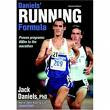 University in Flagstaff, Arizona.
University in Flagstaff, Arizona.Daniels, an Olympian and silver and bronze medalist in the modern pentathlon has been coaching track and cross country for over 31 years. His honors include being named the NCAA "Coach of the Century" and "Worlds Best Coach" by Runners World magazine. Daniels may be the world's leading authority on the application of exercise physiology to train distance runners. Daniels has coached 31 NCAA individual Champions, 8 NCAA Team Championships and 131 All Americans. He has worked with running greats Jim Ryun (who credited Daniels for his success (world mile record holder) in a recent talk at Villanova), Mary Slaney and Joan Samuelson among other Olympians.
Daniels popularized altitude training (as a consultant for the US Olympic team at Mexico City in 1968) and VDOT tables for training. VDOT identifies paces for each runner to train at based on their current level of fitness
Among the local coaches who use the VDOT tables-- which are based on a runners maximum rate of oxygen consumption-- is Coach Bob Bickel, a Moorestown, NJ cross country coach:"We totally use his VDOT tables and methodology to manage a team of 60 runners of very diverse levels. It is the thing that saves us! Tell Coach Daniels, THANK YOU!"
We passed on the thanks to Coach Daniels from Bob and Jim Ryun and had a
 few questions of our own for him as well:
few questions of our own for him as well:Question: Can you tell us about your current work as Coach for the Center for High Altitude Training?
Coach Daniels: "Jack, we have 4 types of runners here (1) those who live here and I coach;
(2) those who live here and I don't coach;
(3) those who spend some weeks here and I coach;
(4) those who are here some weeks each year and I don't coach.
The best runners whom I do coach, do not live here, but come for some weeks each year. These include Magdalena Lewy Boulet (will run the marathon in Beijing), Peter Gilmore (has been top American 2 of last 3 years at Boston marathon and was top American at NY City marathon 2 years ago), Chris Lundy (Made the Olympic Trials). Several others whom I coach do live here - a 15:30 5k girl, 13:44 5k guy; 32:20 10k girl, etc.
Question: We recently talked to Jim Ryun who still has great things to say about your relationship when you coached him during the 60's.
Daniels: "I think I have learned some things from many of the elite runners I have been
 around, Jim Ryun included. "
around, Jim Ryun included. "Question: What do you think is the best way to develop a kick?
Daniels: "The best way to develop a kick is to get fit enough that the bulk of the race doesn't take too much out of you so when it is time to kick you have more energy in reserve than do the others in the race. A kick is the result of feeling relaxed when it becomes time to kick; but not necessarily just having the best speed. Practice doing some quick strides at the end of threshold or interval sessions. "
Question:When you were coaching at Cortland I was intrigued by the fact that you would sometimes hold your runners on the line until well after the starting gun. They would then start out 15 seconds behind the pack and often win (8 national team championships, 25 individual titles and 110 All American Runners at Cortland) Can you give us some insight into your prerace warmup and rational for holding back your runners at the start?
Daniels: "I prefer having my runners do a mile or two easy jog followed by some strides and the final thing they do prior to the start of the race is to run a solid 2 or 3 minute run (about 10 minutes prior to the start). I believe you must start conservatively and use the middle of the race to pass as many people as possible. Passing 40 people in the middle and getting out kicked at the end by 3 people means you got 37 people. Not passing anyone in the middle and outkicking 3 at the end means you beat 3 people. I'd much rather pass big numbers and get outkicked than to pass few and do the outkicking. "
Here are Coach Daniels four ingredients for success:
1) Inherent ability (depends on genetic makeup and talent).
2)Motivation (inner desire to use that talent).
3) Opportunity (includes hindering and facilitating factors in your environment.)
4) Direction (Coaches influence on an athlete).
Coach Daniels: "Don't run as hard as you can. Run as fast as you can without straining."
Scott Douglas also recently talked to Coach Daniels about the psychology of running: "Before cross-country meets I would tell my runners, there are people out there you know you're better than. Beat them. There are people out there who are equal to you. Beat all of them because you ran a smart race. And there might be some people who are better than you. Beat half of them because they ran stupidly. You'd be surprised at how well that works because runners quit
thinking of who they have to beat and where they have to finish and start thinking "What am I doing?"" http://www.scottdouglas.biz/
To access the VDOT Tables
To access Coach Daniels latest Coaching Project: http://www.runsmartproject.com/runsmart.daniels.php
For an updated version of this article see the new book "Positive Splits:"
https://www.amazon.com/Positive-Splits-Running-Stories/dp/1548655341/ref=sr_1_3?keywords=positive+splits&qid=1566215958&s=gateway&sr=8-3
https://www.amazon.com/Positive-Splits-Running-Stories/dp/1548655341/ref=sr_1_3?keywords=positive+splits&qid=1566215958&s=gateway&sr=8-3
1 comment:
Some new VDOT formulas and an Excel spreadsheet for download - http://www.canibaisereis.com/2009/07/27/capacidade-aerobica-maxima-correr-ate-cair-morto/
Post a Comment